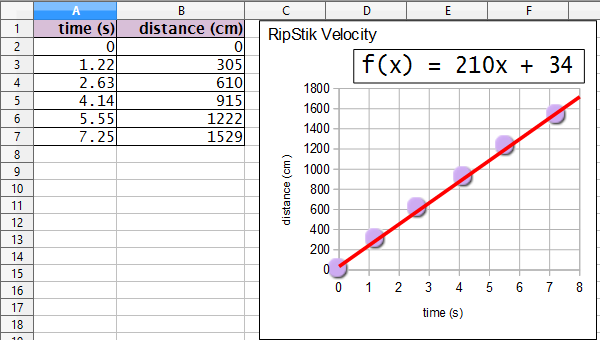- __________ _____ What is the volume of the soap?
- __________ _____ What is the density of the soap?
- ______________ Will the soap float or sink?
- ______________ What brand of soap is this?

- __________ _____ Determine the velocity ѵ of the RipStik.
- __________ _____ If the RipStik continued at that velocity for 60 seconds, how many centimeters would the RipStik travel?
- __________ _____ If the RipStik continued at that velocity for 1819 centimeters, how many seconds would the RipsStik travel?
- __________ _____ Determine the velocity at exactly 6 seconds.
- __________ _____ Calculate the velocity between 8 and 10 seconds.
- __________ _____ Calculate the velocity between 10 and 12 seconds.
- __________ _____ Calculate the acceleration between 10 and 12 seconds.
- __________ _____ How long does the superball fall in seconds?
- __________ _____ What is the speed of the superball?
- _________ __________ Calculate the Gravitational Potential Energy of the child and RipStik at the top of the slope.
- _________ __________ Use the relationship Kinetic Energy = Gravitational Potential Energy to calculate the speed of the child and the RipStik at the bottom of the slope.
- _________ __________ Use the velocity to calculate the momentum of the child and RipStik at the bottom of the slope.
- _____ Identify by the letter which of the mathematical relationships on the graph represents the time versus distance relationship for a RipStik moving at a constant linear velocity with no acceleration (as in the homework 021 in the second week).
- _____ Identify by the letter which of the mathematical relationships on the graph represents the time versus distance relationship for a ball falling under the constant acceleration of gravity g (as in laboratory three).
- _____ Identify by the letter which of the mathematical relationships on the graph represents the height versus velocity relationship for a marble rolling from a height h down a banana leaf and onto a flat table (homework 041).
- _____ Identify by the letter which of the mathematical relationships on the graph represents the length versus mass for a cantilever (as last Friday in class, homework 054).
The student gathered the following data:
Slow marble in: distance = 24 cm, time = 1.2 seconds.
Slow marble out: distance = 24 cm, time = 1.6 seconds.
Fast marble in: distance = 24 cm, time = 0.75 seconds.
Fast marble out: distance = 24 cm, time = 1.0 seconds.
Faster marble in: distance = 24 cm, time = 0.6 seconds.
Faster marble out: distance = 24 cm, time = 0.8 seconds.
- Use the data above to calculate the velocity in and the velocity out. Record the velocities in the table below.
- _________ __________ Calculate the slope of the line.
- _________ __________ Determine the y-intercept of the line.
- ___________ Was velocity gained or lost?
- _________ __________ For a velocity in of 60 cm/s, what is the predicted velocity out based on the data above?
- _________ __________ For a velocity out of 42 cm/s, what is the predicted velocity in based on the data above?
What is the name of the law that causes the balloons to move as they do?
| force (gmf) | load (gmf) |
|---|---|
| 20 | 66 |
| 80 | 264 |
| 140 | 462 |
| 180 | 594 |
- ____________ What is the actual mechanical advantage for the pulley system?
- ____________ The pulley system had four load lines. What is the ideal mechanical advantage?
- ____________ Use the preceding two questions to calculate the efficiency of the pulley system.
- _________℃ What is the temperature of a mix of melting ice and water?
- _________℃ What is the temperature of melting solidified coconut oil?
- _________℃ What is the typical daily indoor room temperature in Pohnpei?
- _________℃ What is the typical daily sunny day outdoor temperature in Pohnpei?
- _________℃ What is the temperature of the healthy living human body?
- _________℃ What is the temperature of a boiling water?